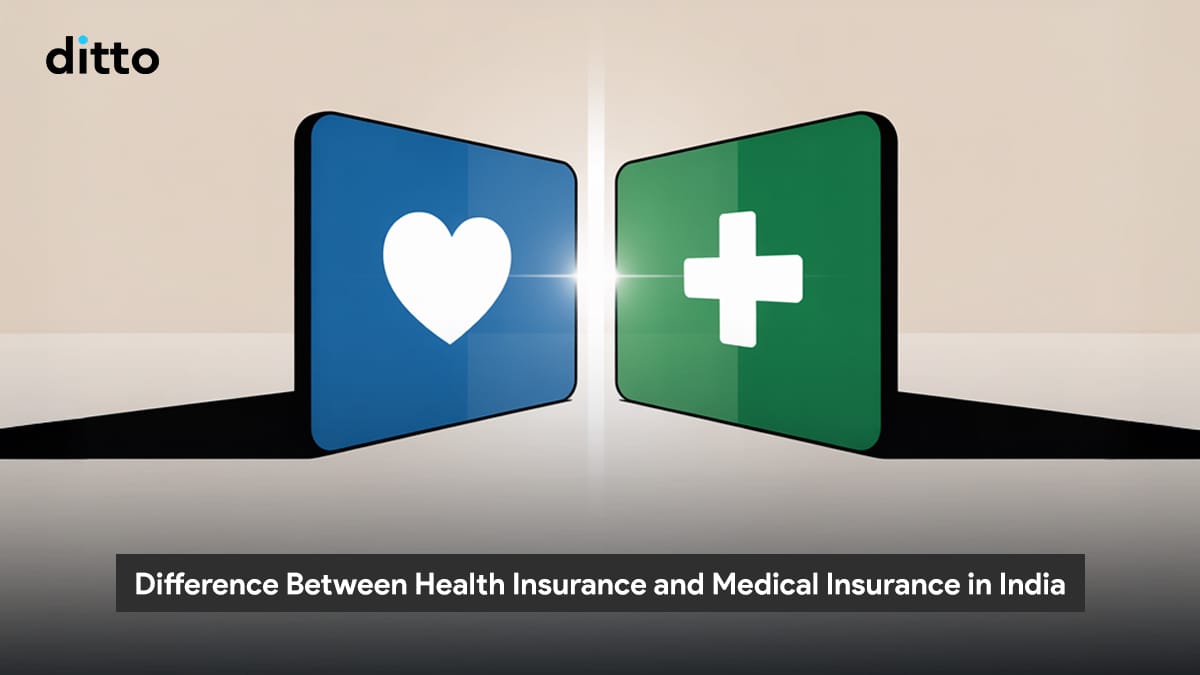What is the Difference Between Health Insurance and Medical Insurance in India?
In India, the terms health insurance and medical insurance are often used interchangeably, but officially, health insurance is a broader, umbrella term that covers a wide range of benefits.
Medical insurance is typically used to refer specifically to hospitalisation indemnity policies; the type of plan that pays for hospitalisation expenses (inpatient treatment). A comprehensive health insurance plan, however, includes medical insurance (hospitalisation) and may also cover consumables, critical illness, personal accident, maternity, and OPD (Outpatient Department) expenses.
The core difference between health insurance and medical insurance in India boils down to scope: one is a part (medical) and the other is the whole (health).
Need help choosing the right plan? Speak to an expert advisor at Ditto and book a free call to get personalised, unbiased guidance — no spam, no hidden fees, just honest advice.
Introduction
Getting the right insurance to protect your finances against unexpected medical costs is a crucial decision. But as you start your research, you'll inevitably bump into two terms that seem to mean the same thing: health insurance and medical insurance. Are they just two names for the same policy? Or is there a difference between health insurance and medical insurance in India?
At Ditto, we've carefully curated this guide based on verified IRDAI definitions, insurer policy documents, and real conversations with our customers so that you can make an informed choice before selecting your insurance plan.
This guide will break down the roles and features of health insurance and medical insurance to help you understand the key differences between them.
Did You Know?
According to IRDAI (Insurance Regulatory and Development Authority of India), “Health Insurance” is the umbrella category that covers all types of medical and health-related insurance. “Mediclaim” or “medical insurance” is simply a subset, referring specifically to the indemnity hospitalization part (the policy that covers hospital bills).
Many people (and even advertisements) use them as synonyms. When you are buying, the crucial check is whether the policy is an indemnity plan (pays hospital bills) or a benefit plan (pays a fixed lump sum on diagnosis, like Critical Illness).
Put simply, the difference between health insurance and medical insurance in India is both formal (regulatory) and functional (what the policy actually pays for).
What is the Role of Health Insurance?
Think of health insurance as a financial safety net for your entire healthcare journey. It's designed to ensure you can access a variety of medical treatments, services, and care without exhausting your savings.
Because it’s an umbrella term, a health insurance policy can be structured to pay a lump sum upon the diagnosis of a critical illness, cover the cost of a surgery, reimburse money spent on diagnostic tests, or even offer gym sessions coverage.
This wide-ranging scope is key to understanding the difference between health insurance and medical insurance.
Salient Features of Health Insurance Plans
A comprehensive health insurance plan is designed to provide all-round protection, typically including a mix of hospitalisation benefits, critical illness coverage, maternity care, wellness benefits, and more. Put simply, health insurance covers more than just hospital bills.
If you’d like to get a complete understanding of popular comprehensive plans and their detailed features, you can read this insightful blog by Ditto: Comprehensive Health Insurance: Meaning, Benefits & Features.
But not every health plan includes all of the features in a similar manner, each plan comes with its own set of in-built features, optional add-ons (riders), and specific exclusions. This is why carefully reviewing the policy document to know the extent of coverage and restrictions is a critical step in the insurance buying journey.
To help you navigate these choices, check out Ditto’s guide on how to choose the right health insurance plan.
What is the Role of Medical Insurance?
The term medical insurance (often called 'Mediclaim' or 'Hospitalisation Indemnity' policy) plays a much more specific, limited role. Its primary and often sole function is to indemnify you against the cost of an acute medical event that requires in-patient hospitalisation.
The word 'indemnify' is important here. It means that the insurance company reimburses or pays for the actual medical expenses you incur, up to the sum insured under your policy. This compensation is strictly tied to the bills generated during a hospital stay (usually defined as a period exceeding 24 hours). If you do not require hospitalisation, the indemnity benefit usually does not apply.
Salient Features of Medical Insurance Plans
Indemnity-Based Payment:
Inpatient Treatment Focus:
Cashless or Reimbursement:
Annual Restoration/Reinstatement:
For a detailed explanation of what a Mediclaim health insurance plan covers, including its benefits, scope, and limitations, you can read this comprehensive guide here.
What is the Difference Between Health Insurance and Medical Insurance?
At Ditto, we’ve seen first-hand how comprehensive health insurance plans give our customers a far stronger financial cushion. When people rely solely on basic medical insurance (Mediclaim), they often discover its limitations too late, for example, when outpatient expenses, diagnostics, or follow-up treatments aren’t covered.
To help you compare at a glance, here’s a clear breakdown of how the two differ in purpose, coverage, and flexibility:
Health Insurance vs Medical Insurance: Key Differences
Our advisors always recommend viewing health insurance as a long-term safety net, not just a short-term hospital cover. The right plan can help you manage both medical emergencies and preventive care and make sure that you don’t compromise on treatment quality or financial stability.
For a comprehensive understanding of the differences between Health Insurance and Mediclaim, including their coverage scopes, claim processes, and suitability for various needs, explore this detailed guide: Health Insurance vs Mediclaim.
Health Insurance vs Medical Insurance: What Ditto Recommends
At Ditto, we recommend opting for a comprehensive health insurance plan because it provides end-to-end coverage for a wide range of healthcare needs. Comprehensive health plans offer greater flexibility through additional riders and higher sum insured limits and adapts better to your evolving health requirements.
In contrast, medical insurance (or Mediclaim) mainly covers hospital expenses incurred during in-patient treatment. While premiums are lower, coverage is restrictive, with sub-limits on room rent, limited flexibility, and no riders.
Standalone Mediclaim policies like the New India Mediclaim Policy still exist but are increasingly rare. They are losing relevance as most insurers today package them under broader health insurance offerings (plans like HDFC Ergo Optima Secure, Care Supreme, Aditya Birla Active One Max, ICICI Elevate).
Difference Between Health Insurance and Medical Insurance: Final Thoughts
The difference between health insurance and medical insurance in India may seem semantic, but it’s important. Medical insurance is fundamentally an indemnity-based hospitalisation plan. It only ensures that hospital bills are paid when you are admitted for treatment. Health insurance, on the other hand, is the broader category that includes medical insurance, but also extends to a variety of health and medical expenses.
Ultimately, when you shop for protection, you shouldn't just look for a 'medical insurance' plan; you should look for a strong and comprehensive health insurance portfolio.
Need help choosing the right plan? Speak to an expert advisor at Ditto and book a free call to get personalised, unbiased guidance — no spam, no hidden fees, just honest advice.
FAQs
Are pre-existing conditions covered in medical and health insurance?
Both types of plans typically exclude pre-existing conditions for an initial waiting period (usually 2–3 years). Comprehensive health insurance offers coverage with optional riders or higher sum insured to better manage long-term care.
Which type of insurance is better for long-term family protection?
Comprehensive health insurance is generally better for families because it covers hospitalisation, daycare, critical illnesses, OPD, maternity, and preventive care (with add-ons). It provides a wider safety net compared to basic medical insurance.
Can I claim tax benefits under medical and health insurance in India?
Yes. Premiums paid for both medical insurance and comprehensive health insurance are eligible for tax deductions under Section 80D of the Income Tax Act, subject to prescribed limits.
Which companies currently offer medical insurance?
A wide range of public and private insurers offer medical insurance, from comprehensive indemnity plans to basic standard policies like the "Arogya Sanjeevani Policy." Companies that offer the Arogya Sanjeevani Policy (among many others): Tata AIG, ICICI Lombard, New India Assurance, Star Health, SBI General Insurance.
What are the limitations of basic medical insurance or Mediclaim policies?
A basic medical insurance or “mediclaim” policy primarily covers in-patient hospitalization expenses but has several limitations compared to modern comprehensive health insurance. These policies often impose mandatory waiting periods for pre-existing diseases (typically 2–3 years) and specific illnesses, and unlike standard health plans, they do not offer add-ons or rider options to waive or reduce waiting periods. Some policies also include a co-payment clause that requires the insured to pay a portion of each claim. Customization is minimal, and coverage is limited to hospitalisation. In short, mediclaim policies do not provide the broader protection and flexibility available under modern health insurance plans.
Last updated on:










